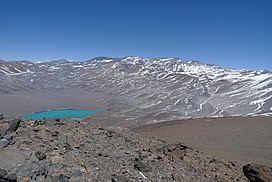| Sierra Nevada de Lagunas Bravas | |
|---|---|
 | |
| Highest point | |
| Elevation | 6,137[a] m (20,135 ft) |
| Prominence | 1,352 m (4,436 ft)[5] |
| Parent peak | Cerro El Condor |
| Coordinates | 26°29′26.88″S 068°33′32.76″W / 26.4908000°S 68.5591000°W |
| Geography | |
| Location | Argentina / Chile |
| Parent range | Andes |
| Geology | |
| Rock age | Holocene |
| Mountain type | Stratovolcano |
| Last eruption | Unknown |
| Climbing | |
| First ascent | Highest summit: 11/05/2014 - Henri Barret (France), Walter Sinay, Eduardo Namur, Claudio Recchia and Guillermo Almaraz (Argentina)[6][7] / Secondary 6127 metre summit - December 12, 2000 - Robert Ayers, Tony Brake, Paul Doherty, Paul Morgan - United States[8] |
Sierra Nevada, also known as Sierra Nevada de Lagunas Bravas, is a major ignimbrite-lava dome complex[9] which lies in both Chile and Argentina in one of the most remote parts of the Central Andes.
Activity in the complex started in Argentina and formed two stratovolcanoes. Later, 12 or more vents formed, some with craters up to 400 metres (1,300 ft) wide. Lava flows up to 7 kilometres (4.3 mi) long with flow ridges are also found. It covers a total area of 225 km2.[10] Radiometric dating has yielded ages of 1.7 ± 0.4 to 0.431 ± 0.012 million years ago,[11] a lava flow from the neighbouring Azufrera Los Cuyanos volcano that is sometimes considered part of Sierra Nevada is 140,000 years old.[12] Together with Cerro el Condor and Peinado it forms the Culampaja line, a line of volcanoes that reaches Cerro Blanco.[13] Strong seismic attenuation is observed beneath Sierra Nevada.[9] Hydrothermally altered rocks in Sierra Nevada may be the source of sulfate and arsenic in the Juncalito and Negro rivers, and heat sources for regional hot springs.[14] The snowline in the area lies at 5,800 metres (19,000 ft) altitude at Cumbre del Laudo.[15]
- ^ USGS, EROS Archive. "USGS EROS Archive - Digital Elevation - SRTM Coverage Maps". Retrieved 12 April 2020.
- ^ "ASTER GDEM Project". ssl.jspacesystems.or.jp. Retrieved 2020-04-14.
- ^ TanDEM-X, TerraSAR-X. "Copernicus Space Component Data Access". Retrieved 12 April 2020.
- ^ Cite error: The named reference
:0was invoked but never defined (see the help page). - ^ "Sierra Nevada / Sierra Nevada de Lagunas Bravas". Andes Specialists. Retrieved 2020-04-12.
- ^ "Revista Digital CCAM 49". Revista Digital CCAM 49. Jan 2015.
- ^ "Vertical N 28". Vertical N 28.
- ^ American Alpine Club Journal. 2002. p. 328.
- ^ a b Kay, S. M.; Mpodozis, C.; Gardeweg, M. (7 August 2013). "Magma sources and tectonic setting of Central Andean andesites (25.5-28 S) related to crustal thickening, forearc subduction erosion and delamination". Geological Society, London, Special Publications. 385 (1): 325. doi:10.1144/SP385.11. S2CID 129489335.
- ^ "Sierra Nevada". Global Volcanism Program. Smithsonian Institution.
- ^ GROSSE, Pablo; GUZMÁN, Silvina; PETRINOVIC, Ivan (2017). "VOLCANES COMPUESTOS CENOZOICOS DEL NOROESTE ARGENTINO" (PDF). ResearchGate (in Spanish). Tucuman: 20th Chilean Geological Congress. p. 508. Retrieved 20 January 2018.
- ^ Polanco, E., J. Clavero, and R. Arcos. "Cadena Volcánica Los Cuyanos-Sierra Nevada: geoquímica y edades Ar/Ar, Zona Volcánica Central, Región de Atacama, Chile (26° 26’S)." XIX Cong Geol Arg Actas S24–3-16 (2014).
- ^ Mulcahy, Patrick; Chen, Chen; Kay, Suzanne M.; Brown, Larry D.; Isacks, Bryan L.; Sandvol, Eric; Heit, Benjamin; Yuan, Xiaohui; Coira, Beatriz L. (August 2014). "Central Andean mantle and crustal seismicity beneath the Southern Puna plateau and the northern margin of the Chilean-Pampean flat slab". Tectonics. 33 (8): 1638. Bibcode:2014Tecto..33.1636M. doi:10.1002/2013TC003393. hdl:11336/35932. S2CID 129847828.
- ^ Aguirre, L.; Clavero, J. (2000). "Antecedentes fisicoquimicos preliminares de cuerpos de agua superficial del Altiplano de la III region de Atacama, Chile" (PDF). biblioserver.sernageomin.cl (in Spanish). 9th Chilean Geological Congress. p. 357. Archived from the original (PDF) on November 6, 2016. Retrieved 5 November 2016.
- ^ Haselton, Kirk; Hilley, George; Strecker, Manfred R. (March 2002). "Average Pleistocene Climatic Patterns in the Southern Central Andes: Controls on Mountain Glaciation and Paleoclimate Implications" (PDF). The Journal of Geology. 110 (2): 215. Bibcode:2002JG....110..211H. doi:10.1086/338414. S2CID 18111576. Retrieved 24 February 2016.
Cite error: There are <ref group=lower-alpha> tags or {{efn}} templates on this page, but the references will not show without a {{reflist|group=lower-alpha}} template or {{notelist}} template (see the help page).
